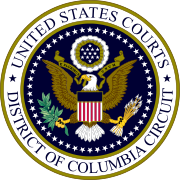Atari Games Corp. v. Oman
| Atari Games Corp. v. Oman | |
|---|---|
 | |
| Court | United States Court of Appeals for the District of Columbia Circuit |
| Full case name | Atari Games Corporation v Ralph OMAN, Register of Copyrights |
| Citation(s) | Atari Games Corp. v. Oman, 979 F. 2d. 242 (D.C. Cir. 1992). |
| Case history | |
| Appealed from | Atari Games Corp. v. Oman, 693 F. Supp. 1204 (D. D.C. 1988). |
| Case opinions | |
| Decision by | Judge Ruth Bader Ginsburg |
Atari Games Corp. v. Oman is an appeal of a court case concerning whether a video game with very simple graphical and audio elements may be copyrighted. Breakout is a paddle and ball video game created by the plaintiff, Atari Games Corporation, initially released in 1976. Eleven years later, in 1987, the plaintiff sought registration for the work with the US Copyright Office. On February 13, 1987, and again on May 22, 1987, Register of Copyrights Ralph Oman refused to register the work because it "did not contain at least a minimum amount of original pictorial or graphic authorship, or authorship in sounds".[1] Atari challenged Oman's decision not to award the game copyright protection.[1]
Prior history[]
Judge John H. Pratt of the United States District Court for the District of Columbia, deferred to the Register and granted summary judgment, dismissing Atari's claim against Oman. He held that "It is simply not the case, in short, that video games are per se copyrightable, or by definition more expressive and creative than other mediums."[1] Atari appealed.
Opinion of the court[]
Soon-to-be Justice Ruth Bader Ginsburg, then sitting on the United States Court of Appeals for the District of Columbia Circuit, and writing for a three-judge panel, reversed the decision of the trial court upholding Oman's ruling and held that Breakout was a copyrightable work and denial of registration was an abuse of the Register's discretion.[2]
In order for a work to be copyrightable, it must be fixed and must possess a requisite level of originality.[3] A then-recent Supreme Court case, Feist Publications, Inc. v. Rural Telephone Service Co., had defined the threshold for originality necessary for copyright as "extremely low; even a slight amount will suffice". In Breakout, the graphics consist of simple colored blocks, elements that the Register contended did not meet the originality threshold. Applying Feist, Ginsburg held that because Breakout consists not only of simple images in isolation, but rather programmed selections of a series of shapes in a particular sequence alongside audio, Breakout met the standard of originality required for copyright, just as a compilation of facts such as a telephone book could meet the threshold of originality by selecting facts to be included, as in Feist.[2]
Importance of the case[]
At the time of the appeal, copyright registrations for similar games formed the basis for litigation for more than a decade; the Register's action threatened to call video game copyrights into question. This case confirms that video games may be copyrighted, and furthermore that a video game whose audio and visual elements may not meet the criteria for copyright in isolation may still be copyrighted when those elements are combined in sequence and that selection of sequence contains appropriate originality.
References[]
- Video game copyright law
- United States copyright case law
- 1992 in United States case law
- United States Court of Appeals for the District of Columbia Circuit cases
- Atari
